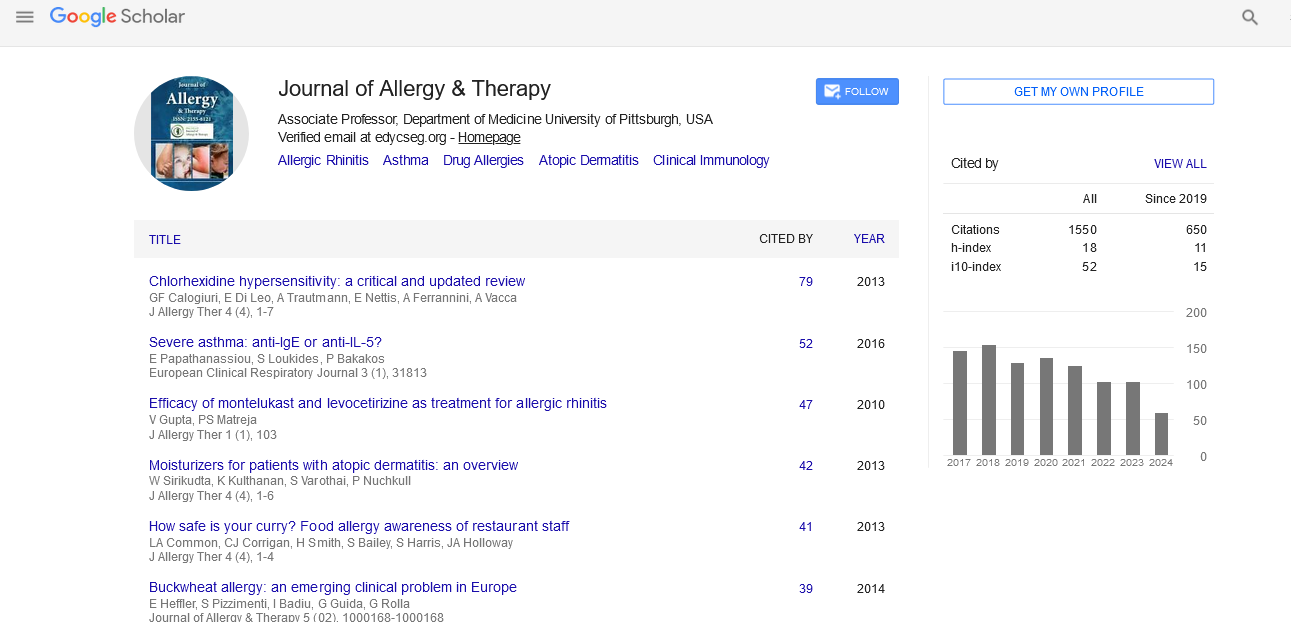Indexed In
- Academic Journals Database
- Open J Gate
- Genamics JournalSeek
- Academic Keys
- JournalTOCs
- China National Knowledge Infrastructure (CNKI)
- Ulrich's Periodicals Directory
- Electronic Journals Library
- RefSeek
- Hamdard University
- EBSCO A-Z
- OCLC- WorldCat
- SWB online catalog
- Virtual Library of Biology (vifabio)
- Publons
- Geneva Foundation for Medical Education and Research
- Euro Pub
- Google Scholar
Useful Links
Share This Page
Journal Flyer

Open Access Journals
- Agri and Aquaculture
- Biochemistry
- Bioinformatics & Systems Biology
- Business & Management
- Chemistry
- Clinical Sciences
- Engineering
- Food & Nutrition
- General Science
- Genetics & Molecular Biology
- Immunology & Microbiology
- Medical Sciences
- Neuroscience & Psychology
- Nursing & Health Care
- Pharmaceutical Sciences
Short Communication - (2023) Volume 14, Issue 4
Multifaceted Advantages of Eliminating Gluten from our Diet
Giselle Foureaux*Received: 20-Jul-2023, Manuscript No. JAT-23-22259 ; Editor assigned: 24-Jul-2023, Pre QC No. JAT-23-22259 (PQ); Reviewed: 07-Aug-2023, QC No. JAT-23-22259 ; Revised: 14-Aug-2023, Manuscript No. JAT-23-22259 (R); Published: 22-Aug-2023, DOI: 10.35248/2156-6121.14.353
Description
Gluten-related disorders have become conditions under growing public health issue everywhere in the world. To shed light on various aspects of gluten, our research group recently published a review about it [1]. The spectrum of gluten-related disorders includes Celiac Disease (CD), Wheat Allergy (WA) and Non- Celiac Gluten Sensitivity (NCGS).
The CD is an autoimmune enteropathy based on genetic susceptibility and triggered by the exposure of gluten, causing inflammation and immune responses. It is one of the most frequent lifelong diseases, affecting approximately 1%-2% of the general population worldwide [2]. WA is a food allergy characterized for immune response mediated by IgE [1]. NCGS is a condition characterized by intestinal and extra-intestinal symptoms unleashed by the ingestion of gluten containing foods [3]. The diagnostic criteria of NCGS include elimination of CD and WA, symptom relief on a Guten-Free Diet (GFD) and symptom recurrence triggered by a gluten re-challenge. Similar clinical manifestations can be observed in those disorders, such as: abdominal pain and distension, diarrhea, constipation and vomit. Other problems can be related, some of these claims include headache, anemia, fatigue, dermatitis herpetiform and liver problems.
Determining the true prevalence of gluten-related disorders, particularly NCGS, has been a subject of debate. NCGS lacks specific serological or genetic markers for diagnosis, making it challenging to establish accurate and reliable diagnostic criteria. Additionally, self-diagnosis further complicates prevalence estimates. However, when examining the broader context of gluten-related issues (listed below), these prevalence numbers become less relevant.
Relationship between gluten, ultra-processed products and non-communicable chronic diseases
The first point to be considered is the fact that the massive introduction of processed foods in recent years may represent a large part of the cause not only of gluten-related disorders [4], but also of Non-Communicable Chronic Diseases (NCDs). NCDs, such as obesity, diabetes, heart disease and cancer, are the major cause of death globally. It is not possible to dissociate wheat (and gluten) consumption from ultra-processed products. Against this background, studies have shown that consuming foods with antioxidants and bioactive compounds that can counteract oxidative stress and inflammation may represent a strategic tool for maintaining health and well-being, preventing NCDs [5], as well as, food allergies and intolerance.
Gluten indigestibility in healthy individuals
Gluten, the major structural protein of the wheat, is characterized for two parts: soluble gliadins and poorly soluble glutenins. Gliadin cannot be degraded by digestive system, and when it passes by the gut barrier the immune system is activated. It has been demonstrated that gliadin, even in healthy subjects, can determine a prompt and transient increase in gut permeability which is related to the amount of the peptide ingested [6]. Therefore, it can be presumed that even individuals without diagnosed gluten disorders may exhibit some degree of gluten sensitivity.
Undigested gluten fragments and exorphins
Gliadin is degraded to a collection of polypeptides called exorphins in the gastrointestinal that mimic endogenous opioid activity. Pruimboom et al., raise the fact that a large group of patients, positive for the presence of CD antibodies and with proven histological CD, do not suffer from any gastrointestinal symptoms, and suggest the possibility of the opioid effects of gluten itself mask the classic symptoms of CD [7]. Gluten consumption can cause anatomical changes in the brain, as demonstrated by magnetic resonance imaging studies showing bilateral decreases in cortical gray matter and caudate nuclei [8]. Furthermore, those exorphins have the capacity of bind opioidreceptors and show results in central nervous system and peripheral nervous system. Therefore, exorphins has an interaction in brain as insider compounds, however, are produced outside of the brain. Takahashi et al. have demonstrated that food derived exorphins are bioactive and impair the spontaneous behavior, memory, anxiety and pain perception in rodents [9]. To aggravate, changing eating habits increases the amount of these exorphins in the blood, which can directly affect the body, since, unlike endorphins that are produced on demand, exorphins respond to food intake.
Safety and benefits of Gluten-Free Diet (GFD)
For the treatment of CD, a lifelong GFD is well-established. However, the scientific community remains hesitant when it comes to other gluten disorders and individuals who seemingly do not have gluten sensitivity. Furthermore, adopting a GFD in healthy individuals is often met with strong opposition.
The nutritional profile of gluten-free products has raised concerns, with studies indicating that processed gluten-free foods are less nutritionally adequate than standard products. It is very important to emphasize that just replacing glutencontaining cereals with gluten-free ultra-processed foods of low nutritional quality can contribute to a GFD having a negative impact on health. Otherwise, a well-implemented GFD has shown potential benefits such as reducing lipid concentration, visceral adiposity, adipocyte size, suppressing inflammation, and improving insulin sensitivity in mice [10]. In humans, a GFD has improved metabolic syndrome, irritable bowel syndrome, and athletic performance; and decreased the symptoms of fibromyalgia and endometriosis [11].
Conclusion
From this comprehensive perspective on gluten, which goes beyond the scope of gluten-related disorders and includes considerations of gluten indigestibility in health individuals, the formation of exorphins, and the strong association between gluten and ultra-processed products with NCDs, it becomes evident that eliminating gluten from the diet can significantly contribute to improving overall health of the individual. Individuals choosing to adopt a GFD should keep in mind that just replacing processed glutencontaining foods with gluten-free processed foods may not necessarily improve the quality of their diet. It is advisable to reduce the consumption of processed foods in general. Opting for foods rich in high-quality proteins, beneficial fatty acids, antioxidants, polyphenols, vitamins, trace elements, and minerals can contribute to a safe and healthy GFD when personalized to individual needs. Lastly, future research should aim to provide a clearer understanding the role of the gut-brain axis in gluten-related neurological effects is relevant, as it may involve interactions between the gut microbiota, immune system, and the central nervous system.
References
- Franckilin LRS, Dos Santos AC, Freitas FE, Vieira IG, Freitas Jorge CE, Neri DG, et al. Gluten: do only celiac patients benefit from its removal from the diet?. Food Rev Intern. 2022;1-31.
- Guandalini S, Assiri A. Celiac disease: a review. JAMA pediatrics. 2014;168(3):272-278.
[Crossref] [Google Scholar] [PubMed]
- Singh P, Arora A, Strand TA, Leffler DA, Catassi C, Green PH, et al. Global prevalence of celiac disease: systematic review and meta-analysis. Clin Gastroenterol Hepatol. 2018;16(6):823-836.
[Crossref] [Google Scholar] [PubMed]
- Khan A, Suarez MG, Murray JA. Nonceliac gluten and wheat sensitivity. Clin Gastroenterol Hepatol. 2020;18(9):1913-1922.
[Crossref] [Google Scholar] [PubMed]
- Zekrumah M, Razak A, Wahab J, Moffo N, Ivane A, Zou X, et al. Dietary Polyphenols-Role in Non-Communicable Chronic Disease Prevention, and Interactions in Food Systems. An Overview. Nutrition. 2023;112034.
[Crossref] [Google Scholar] [PubMed]
- Silano M, Vincentini O, De Vincenzi M. Toxic, immunostimulatory and antagonist gluten peptides in celiac disease. Curr Med Chem. 2009;16(12):1489-1498.
[Crossref] [Google Scholar] [PubMed]
- Pruimboom L, De Punder K. The opioid effects of gluten exorphins: asymptomatic celiac disease. J Health Popul Nutr. 2015;33(1):24.
[Crossref] [Google Scholar] [PubMed]
- Bilgic B, Aygun D, Arslan AB, Bayram A, Akyuz F, Sencer S, et al. Silent neurological involvement in biopsy-defined coeliac patients. Neurol Sci. 2013;34:2199-21204.
[Crossref] [Google Scholar] [PubMed]
- Takahashi M, Fukunaga H, Kaneto H, Fukudome SI, Yoshikawa M. Behavioral and pharmacological studies on gluten exorphin A5, a newly isolated bioactive food protein fragment, in mice. Jpn J Pharmacol. 2000;84(3):259-265.
[Crossref] [Google Scholar] [PubMed]
- Soares FL, Oliveira Matoso R, Teixeira LG, Menezes Z, Pereira SS, Alves AC, et al. Gluten-free diet reduces adiposity, inflammation and insulin resistance associated with the induction of PPAR-alpha and PPAR-gamma expression. J Nutr Biochem. 2013;24(6):1105-1111.
[Crossref] [Google Scholar] [PubMed]
- Niland B, Cash BD. Health benefits and adverse effects of a gluten-free diet in non–celiac disease patients. Gastroenterol Hepatol. 2018;14(2):82.
[Google Scholar] [PubMed]
Citation: Foureaux G (2023) Multifaceted Advantages of Eliminating Gluten from our Diet. J Allergy Ther. 14:353.
Copyright: © 2023 Foureaux G. This is an open-access article distributed under the terms of the Creative Commons Attribution License, which permits unrestricted use, distribution, and reproduction in any medium, provided the original author and source are credited.


